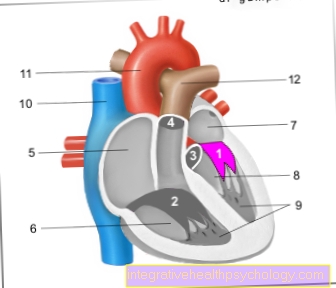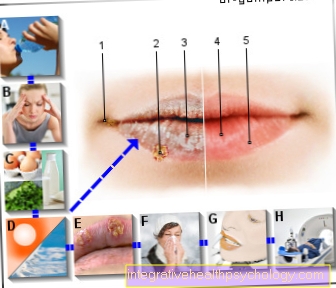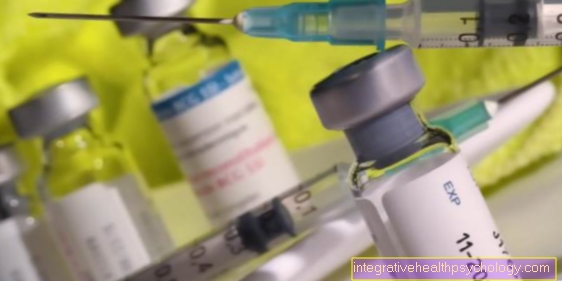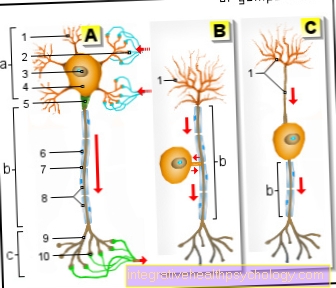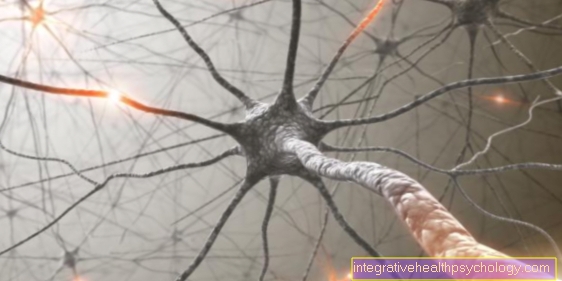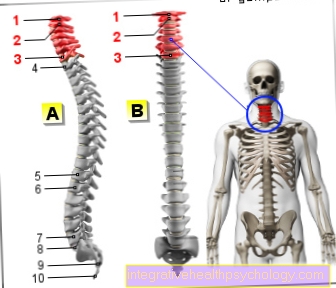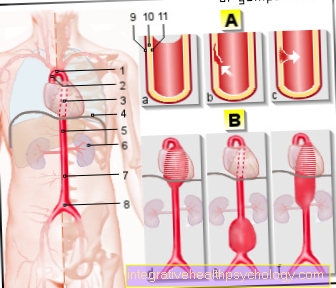Anemia in old age - dangerous?
introduction
Anemia (anemia: an = not, emia = blood) describes a decrease in the red blood pigment (hemoglobin), the number of red blood cells (erythrocytes) or the proportion of cells in the blood (hematocrit).
One speaks of anemia when the hemoglobin falls below 13 g / dl in men or below 12 g / dl in women. Alternatively, there is anemia if the hematocrit is below 42% in men or below 38% in women.
There is no precise age limit for the use of the term “anemia in old age”. Mostly people are meant beyond the retirement age.With age, the proportion of affected people suffering from anemia increases continuously. Anemia does not always have a disease value, but you should definitely get to the bottom of it in order to rule out treatable underlying diseases.
Recognizing anemia in old age
Symptoms of anemia in old age
Typical symptoms of anemia include paleness of the skin and mucous membranes. In addition, general weakness, reduced performance and increased tiredness can occur. There may be other symptoms such as headache, often tearing corners of the mouth (angular mouth rhagades), increased heart rate and poor concentration.
All of these symptoms are very unspecific and can indicate many different diseases. In old age, in particular, the symptoms are often only mild. Particularly in the case of chronic anemia in old age, the symptoms often go unnoticed by those affected. In addition, the symptoms can easily be confused with general signs of aging. Therefore, anemia in old age is often a diagnosis that occurs by chance.
For more information on this topic, we recommend our page on: Symptoms of anemia
Further indications of anemia in old age can be the consequences of anemia:
The reduced number of red blood cells and red blood pigment leads to an overall decrease in health. The risk of falling increases, while mobility is reduced, for example due to a shorter walking distance and less strength. The memory can also suffer from anemia, affected people become forgetful more quickly, and the risk of dementia increases. Anemia can also reduce bone density in old age. In addition, anemia can affect mood and lead to depressive symptoms.
Also read: Consequences of anemia
More about this topic can be found: Symptoms of anemia
Fatigue as a sign of anemia
Tiredness and exhaustion, along with a generally reduced performance, are common symptoms of anemia in old age.
The red blood pigment is responsible for transporting oxygen in the blood. If the anemia reduces the capacity for oxygen transport, this can lead to a slight lack of oxygen in important organs. Less oxygen in the brain, for example, leads to a feeling of tiredness, and affected people often yawn. In addition, the heart has to pump harder in order to supply all organs with sufficient oxygen. This leads to general exhaustion as well as reduced physical performance.
Chronic anemia can also lead to slow chronic damage due to the slight lack of oxygen in the various organs. This becomes noticeable in the brain, for example, through faster forgetfulness. The muscles are also no longer as well supplied and break down faster, which reduces physical performance more strongly.
Read more on this topic: Chronic fatigue
We also recommend our site to: Symptoms of anemia
Diagnosis of anemia in old age
The diagnosis of anemia is initially based on well-founded suspicion. These can e.g. Blood in your stools, black stools, feeling very tired or pale. A blood test can then be performed. The main focus is on the red blood pigment (hemoglobin), the proportion of blood cells in the blood (hematocrit) and the red blood cells (erythrocytes).
Anemia can be determined from these three values alone. To find out the cause, the iron level and ferritin (transport protein for iron in the blood) should also be examined.
It is also useful to have a stomach and / or colonoscopy to find and treat bleeding sources in the digestive tract. If this does not lead to an explanation for the anemia in old age, further diagnostic steps such as a bone marrow aspiration with an examination of the blood formation can be carried out.
Anemia can manifest itself through various symptoms. You should therefore also read: Symptoms of anemia
Treatment of anemia in old age
The treatment of anemia in old age basically depends on the cause of the disease.
Deficiencies can be compensated for by administering appropriate preparations.
Iron tablets should be taken for several months in the event of anemia due to iron deficiency. In addition, you can improve iron absorption through food by increasing the consumption of iron-rich foods. These include, for example, meat, fish, lentils, peas, spinach, beans, etc. In addition, care should be taken to ensure that vitamin B12 and folic acid are sufficiently supplied and, if necessary, taken with medication.
If the anemia in old age is based on a chronic disease, this should be stopped as best as possible. In the case of chronic bleeding, the sources of bleeding in the gastrointestinal tract should be found by a gastroscopy or colonoscopy and closed. If the anemia is particularly severe, an immediate blood transfusion may be necessary. If the anemia is caused by poor kidney function in old age, drugs that increase blood production may also be given.
More about this topic can be found: Treatment of anemia
When do you need a blood transfusion?
A blood transfusion is required when the anemia is particularly severe. There are two reasons for this: There can be sudden (acute) severe blood loss. This may require a blood transfusion before the blood values deteriorate measurably. Therefore, the consideration of a blood transfusion for acute bleeding depends on both clinical status and hemoglobin level. In the case of severe complaints such as significantly increased heart rate, drop in blood pressure, shortness of breath, but also changes in heart activity in the ECG, a blood transfusion may be necessary from a hemoglobin value of 10 g / dl (normal value 12-13 g / dl).
From a hemoglobin value of 8 g / dl, a blood transfusion is necessary in the case of previous diseases of the cardiovascular system, even without symptoms. If the hemoglobin is below 6 g / dL, a blood transfusion should always be performed. The same limit values also apply to chronic blood loss, which usually goes unnoticed and therefore rarely shows symptoms.
Read more on this topic at: Blood transfusion - when is it necessary?
Duration and prognosis of anemia in old age
How long an anemia lasts depends on how the cause is remedied.
In acute bleeding, rapid recovery can take place if the bleeding is stopped quickly.
Recovery takes longer, especially in the case of chronic anemia in old age, but it is often easy to manage through a targeted supply of iron via diet and medicinal iron. In the case of chronic bleeding, it is also important that the cause is found and treated. If the anemia in old age is based on a benign disease, the prognosis is good with prompt treatment.
The prognosis for malignant diseases (tumor in the digestive tract, malignant blood formation disorders) depends heavily on the individual disease.
You might also be interested in: Consequences of anemia
When does anemia become dangerous?
Anemia can become dangerous through various mechanisms. For example, unnoticed anemia in old age can lead to complications such as a decrease in performance, reduced bone density, increased falls and consequential injuries such as bone fractures. A broken bone is not in itself a life-threatening disease, but it can result in long hospital stays and bed confinement with the risk of long-term care and an increased risk of infection.
Chronic bleeding can also permanently damage brain function and become dangerous over a long period of time. Another type of danger comes from malignant diseases that cause anemia in old age. These should be treated as quickly as possible in order to obtain the best possible prognosis and to minimize the risk.
Further information on this topic can be found at: Consequences of anemia
Causes of anemia in old age
The causes of anemia in old age basically differ little from the causes of anemia in any other age. However, the frequencies of the underlying cause are distributed differently.
1. In most cases, deficiencies lead to anemia in old age. Typically, there are nutritional problems (unbalanced diet or insufficient intake) that lead to a deficiency in iron, folic acid or vitamin B12. However, the body needs all of these components in order to continue to produce red blood pigment and red blood cells. Therefore, a deficiency in these substances can lead to anemia.
Also read:
- Lack of ones
- Folic acid deficiency
- Vitamin B12 deficiency
2. Another cause is anemia in chronic diseases. Many elderly people suffer from several chronic diseases. These lead to a reduced drive for blood formation (e.g. in the case of kidney diseases) or to the fact that red blood cells break down more quickly and have to be replaced by new ones (e.g. diseases of heart valves).
Also read: Chronic disease anemia
3. Other causes can be chronic blood loss (often in the gastrointestinal tract) from ulcers in the stomach or duodenum, or from diverticula in the lower intestine. Chronic blood loss (sometimes unnoticed) can also indicate growth processes in the intestine. In some cases, severe anemia can also be traced back to diseases of the blood-producing system (such as the bone marrow).
Also read: Gastrointestinal bleeding
Iron deficiency anemia
Iron deficiency is the leading cause of anemia in old age.
There are many reasons for iron deficiency. A reduced intake of iron (most often with a vegetarian / vegan diet, but also with fundamental malnutrition) can be the reason for the iron deficiency. Reduced absorption in the digestive tract due to stomach or intestinal diseases can also cause iron deficiency. Anemia occurs less frequently in old age due to an increased iron requirement (typical for athletes, growing children, pregnant women). On the other hand, iron losses through chronic bleeding in the digestive tract become particularly common in old age.
A detailed examination of the gastrointestinal tract (gastroscopy, colonoscopy, test for hidden blood in stool) should therefore be carried out in the event of anemia in old age with low iron levels.
More about this topic can be found: Iron deficiency anemia or Iron deficiency and its causes
Can cancer be a cause of anemia?
Cancer is one of many causes that can be responsible for anemia in old age. Other causes of the anemia, such as chronic diseases or bleeding from the gastrointestinal tract, are much more common. However, chronic bleeding can also indicate a benign or malignant tumor in the stomach or colon. For this reason, for example, regular colon cancer screening with a test for hidden blood in the stool is a sensible measure.
Much less often, anemia in old age is an indication of diseases of the hematopoietic system. However, cancer (leukemia) can also occur in this area in old age.
Anemia in old age can be an indicator of cancer. As a preventive measure, a test for hidden blood in the stool is carried out every year from the age of 50. Read more about this at: Test for blood in your stool
We also recommend our site to: Colon Cancer Screening - What You Should Know!



